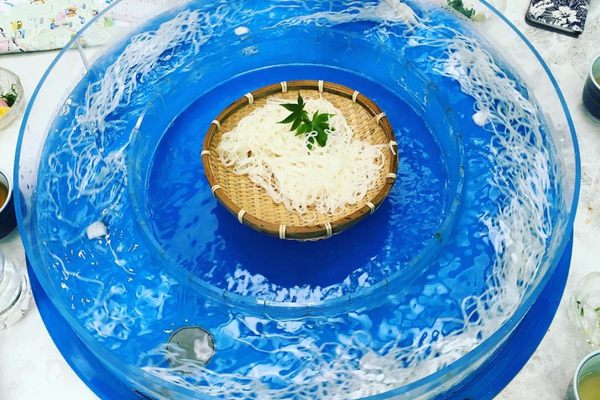Every time a sushi chef prepares blowfish, he holds enough poison in his hands to kill 30 patrons. Their rapid and violent deaths would be caused by tetrodotoxin, a neurotoxin up to 1,000 times more deadly than cyanide. The victims, first tipped off by numbness around their mouths, would remain paralyzed (and conscious) until the end. For many Japanese diners, this is hardly a deterrent: Every year, 10,000 people in the island nation find themselves lured in by the danger, luxury, and distinctive texture of meticulously prepared blowfish, called fugu.
This is not a risk that Japan takes lightly: The certification period to become a government-authorized fugu chef in Tokyo takes several years and ends with a test. A third of the test-takers fail, and no one can even attempt it until they turn 20 years old, the age of legal adulthood in Japan. In 2012, there were reports that the government was considering relaxing these policies, but the strict requirements remain. Sushi chefs must also store fugu’s inedible portions (notably, its lethal ovaries, intestines, and liver) in a padlocked metal drum destined for the city’s primary fish market, where its contents will be burned. What remains of the animal’s square body is made into an expensive feast that invites customers to feel as if they’re testing fate.
Diners begin their fugu-centric meal with petal-thin slices of sashimi, often plated in the shape of a chrysanthemum, a Japanese symbol of longevity. Blowfish flesh is firm enough that thicker pieces are challenging to chew, but its flavor is so nuanced that some say they only taste the accompanying dipping sauce. After the sashimi course, servers might cook a soup called fugu chiri or a rice porridge (fugu ojiya). Even the signature drink imparts diners with a sense of excitement: Hire-zake infuses dried, toasted fins into a cup of piping hot sake.
All of this rigorous training and prep work results in a hefty price tag. A single plate can cost up to $200. But clearly, the risk is worth the reward, even if the reward is mostly the feeling of risk-taking.
Where to Try It
-
Fuku Ryori Shinoda
Imauracho 7-9, Shimonoseki, Yamaguchi, 750-0064, JapanThe best-known fugu restaurant in Shimonoseki, the “Blowfish Capital of Japan.”
-
This long-standing Japanese restaurant offers a full menu of varied fugu preparations.
Written By
 rachelrummel
rachelrummel
Sources
- content.time.com/time/specials/packages/article/0,28804,1967235_1967238_1967227,00.html
- www.bbc.com/news/magazine-18065372
- www.bbc.com/news/world-asia-42699600
- www.nytimes.com/1981/11/29/travel/one-man-s-fugu-is-another-s-poison.html
- factsanddetails.com/japan/cat19/sub123/item649.html
- theculturetrip.com/asia/japan/articles/7-of-the-safest-places-to-eat-blowfish-in-japan/
- www.ncbi.nlm.nih.gov/pmc/articles/PMC3942760/
- www.theguardian.com/world/2016/aug/05/last-supper-japan-killer-puffer-fish-fugu
- guide.michelin.sg/en/8-michelin-starred-fugu-restaurants-in-japan
- books.google.com/books?id=4IAlLDQWZGMC&pg=PA91&lpg=PA91&dq=Hire-zake&source=bl&ots=i6SCuqjdEd&sig=dV-f_Ediq8nq-UMZq1MmQkKExdU&hl=en&sa=X&ved=0ahUKEwi0g6zrkKTaAhWlVt8KHfURB5I4ChDoAQhJMAY#v=onepage&q=Hire-zake&f=false
- www.nationalgeographic.com/animals/fish/group/pufferfish/




















